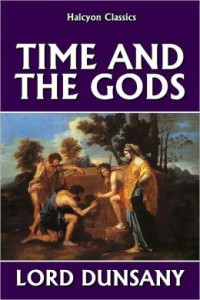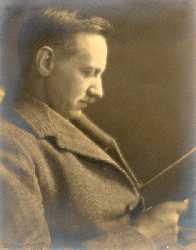Lord Dunsany Re-read: Time and the Gods Part 2
 Bill Ward and I are continuing our Lord Dunsany re-read with the next two stories published in the original Time and the Gods (not the omnibus). You can find a free copy of the book here and join in the discussion. Our rating system is pretty simple. One star is a standout, and two stars is truly notable. Most of Lord Dunsany’s fantasy work is already fairly remarkable, so even a “no star” story on this scale may be worth a look.
Bill Ward and I are continuing our Lord Dunsany re-read with the next two stories published in the original Time and the Gods (not the omnibus). You can find a free copy of the book here and join in the discussion. Our rating system is pretty simple. One star is a standout, and two stars is truly notable. Most of Lord Dunsany’s fantasy work is already fairly remarkable, so even a “no star” story on this scale may be worth a look.
First with “The Coming of the Sea” last week and then with this week’s “A Legend of the Dawn” and “The Vengeance of Men,” we’re coming to Lord Dunsany at his best, where the excellence of his writing becomes a matter of routine. Much like the ease with which Lennon and McCartney seemed to be able to crank out hit singles, one by one Lord Dunsany conjures up these little gems of fable, each dripping with amazing moments and phrases and concepts. Creating myths-that-should-have-been, he explains the different ways that twilight falls and the different enemies conspiring to steal the sun, and the birth of the moon and the stars, and describes how pestilence stalks men. In a word, it’s fantastic. Perhaps only Tanith Lee has invented so many stories that feel so much like they might have been myths conceived by and spread through an entire ancient culture. I’ll turn it over to Bill for more specific analysis.
Bill: “A Legend of the Dawn:” * Here is Dunsany’s creation myth of the day/night cycle, and instead of a metaphor of life and rebirth, Dunsany offers the charming notion of a child and her beloved toy. Iuzana, a child of all the gods, plays with the golden ball of the sun, throwing it high in the air to create the first day, though eventually it falls back to earth and is lost. In a cycle that repeats itself seven times (and in many places parallels the biblical genesis myth) various gods go to reclaim the sun, for none can abide to see the Dawnchild despondent at the loss of her toy (not even the silver ball of the moon, given to her when she lost the sun, can appease her).
There is some really creative metaphorical story telling here — such as all the gods creating the stars as torches in their search for the golden ball, and all those stars being extinguished by Night once the ball was reclaimed outside of her cave — and it really feels like a cohesive myth. The end, promising a future apocalypse for the gods (and tying in with the next story) is startling after a somewhat playful story of innocence and devotion, and is much stronger than the literal apocalypse that happens in the climax to “Time and the Gods,” for here we see the gods as beings with personality and emotion.
Howard: Bill saw further than me on this one. I had actually grown just a little weary of Iuzana constantly losing the ball, but Bill counted and found the seven days of the week (rather than the eight to which Lennon/McCartney allude). Kudos to Bill for seeing it and golf clap to Lord Dunsany for giving us a full week. And two stars from me for what I think is simply a brilliant little myth, for all of its fine touches. But are there no goddesses? For apart from Iuzana, child of all the gods, I find none mentioned. I can’t recall if some turn up later. I hope so.
Bill: “The Vengeance of Men:” It’s clear at this point that this story cycle is a chronological unfolding of the Pegana “mythos,” and this story follows more or less directly from the previous one. Our first mention of mortal men is when, on the seventh day, Iuzana gives her golden ball to a human boy to play with in the last tale, and the eventually apocalypse of the gods previously alluded to is the crux of “The Vengeance of Men.”
The language of the King James Bible seems even stronger here than before, which is most suited to the subject matter of the men of Arim, forgotten of the gods, who made gods of their own and were punished for it by Pestilence. In the end it is a mortal priest who sees what the gods cannot, and informs them of their eventual doom — so now the gods must live out their existence always dreading their prophesied fate. Dunsany does a magnificent job of moving from an almost playful tale to one that weighty and grim, despite both stories being stylistically consistent with one another.
Howard: I think you’re right with the King James Bible tone. I don’t know that I’ve been this creeped out by the depiction of the vengeance of a god since the first time I saw the plagues from The Ten Commandments. Pestilence is downright frightening. All the different ways that it attacks humans are chilling (and that it can only be seen by them once it has gripped them). But then the casual way that the gods send forth pestilence is chilling as well, and it is nice to think that there is some justice coming to the gods for being so callous with their handing down of fates. One star from me for this one.
Of the two, “A Legend of the Dawn” is my favorite not just because of all the reasons we already cited, but for a dozen other moments, like the hound of the gods which is thunder, or the rain and mist that carry away the sun, pursued by the valiant north wind and his sword of ice, or the descriptions of the mountains that seem to hide the golden dawn in a brilliant casket. Beautiful, beautiful stuff. Lord Dunsany is not only masterful and inspiring, he’s peerless. I’m wanting to run out and grab other fantasy readers and shake them and say: “Read this! It’s great! Until you try this you won’t see that you’re nattering on about lesser artists — see how a genius does it!”
Next week Bill and I will continue reading, moving on to “When the Gods Slept” and “The King That Was Not.” Hope to see you here.


2 Comments